You are using an out of date browser. It may not display this or other websites correctly.
You should upgrade or use an alternative browser.
You should upgrade or use an alternative browser.
Canadian Surface Combatant RFQ
- Thread starter jmt18325
- Start date
Objectively, it doesn't seem to have been hyped any more than a large number of other defence related products and systems out there.I agree with @Underway on this. CEAFAR and CEAFAR 2 are hugely hyped by Australian industry, (understandable - they are trying to create a domestic industry), but have not had any international sales success, which says something, surely. Being physically heavy because of cooling requirements does not indicate anything with regards to capability, other than the panels are probably not electrically efficient, which is not a good thing. Nothing I've read in the public domain would lead me to conclude that CEAFAR2 is a superior radar system. That does not mean it's a bad radar system. It's just not the cat's meow some make it out to be. I believe we chose well with SPY7 for CSC.
As for other sales, following their selection by the Aus DoD to provide land abased radars for the Joint Integrated Air and Missile Defence program, I suspect CEA's production capacity is pretty much fully booked for the foreseeable future.
Rainbow1910
Member
- Reaction score
- 534
- Points
- 810
That is a fair point regarding the submarines procurement, it's a very long term goal and Australia still requires a modern ASW capability. I hope all of this nonsense about cutting Hunter for corvettes or a less capable vessel class is not true. Since my initial post, it seems that BAE had to cut much of the ASW equipment aboard this AAW Hunter variant, so I am not supportive of the concept anymore. A proper Hobart replacement very well is likely the answer instead, although that is an entirely different can of worms. I think most modern warships are decently capable of seeing unmanned threats, especially as many of them are in their infancy and rather impotent. That is unlikely to be the case forever but I think warships themselves are pretty well set to deal with these threats in the future.Those subs won't be anywhere near Australia for a long time, the Hunter will be available much sooner, as such Australia need submarine defence. Also lets break this down for a minute.
The Aussie press is very tabloidy and are creating a tempest in a teapot. Australian defence planning has suddenly become a popularity contest done in public instead of by the sober house of commons where they had a good thing going with multiparty support of the defence spending generally. Recently its become quite a circus with a lot of non-experts/self proclaimed experts complaining.
- Does anyone actually think China is going to try and attack Australia? - unlikely, China wants to project power near to their shore based support
- If they are what naval units are most likely to be able to do that? - submarines are
- Does anyone actually think that ANY ship can survive inside the first island chain? - no one thinks this, even the US is planning a second island chain defence with projecting power into the first island chain
- Is Australia expecting to send expeditionary units into the South China sea and fight? - perhaps, but since no ship can survive why would you do that?
- Given this information what platform is more important? - I would argue a GP frigate is more important, particularly with UXV warfare becoming a thing
It seems fairly clear to me that Australia will be one of the nations in the crosshairs of China during a conflict in the Pacific going forward. With their extremely close relationship with the United States alongside other partners now and especially going forward with things like bomber and SSN basing in Australian territory, they are a proper target for China to strike. Australia also has foreign interests and obligations to defend various smaller Pacific states/islands that potentially could be on the chopping block in a conflict, alongside the fact that Australia, being an island nation, is reliant on maritime shipping to survive. China will be constrained within the various Island Chains but I think it is something to consider that they could break assets out during wartime to threaten the greater Pacific. There is a fine line to step without falling into conspiracy and paranoia however, Australia moving to seriously upgrade its defense with programs like AUKUS show that China is a key threat that needs to be met.
The Australian media is a fustercluck regarding the amount of biased individuals throwing out their two cents, it makes me happy that our media doesn't more closely follow defence. our talking heads can be their own kind of.....unique but they are atleast few in number/limited in their reach.
Rainbow1910
Member
- Reaction score
- 534
- Points
- 810
Dr. Steve Wills (Navalist at the Center for Maritime Strategy) recently had a good interview with Vice Admiral Angus Topshee (Commander of the Royal Canadian Navy) regarding many different topics and the RCN. Around the 11:50 mark, they begin to speak about the procurement and Canadian Surface Combatant specifically.
Here is a few facts I picked out, some of this info has been known but it has been again specifically mentioned here.
- Topshee continues to refer to the CSC as a destroyer.
- A projected 8,000t - 9,000t displacement (Full, light, normal, unsure?).
- 24 Mark 41 VLS on the CSC + 24 shorter range missiles (I assume this refers to CAMM but it was not mentioned by name).
- Current missile armament is not viewed as sufficient against peer/future threats however, it was thought that the ship would need to be enlarged to fit more missiles and this would cause a variety of issues not deemed worthwhile.
- Options are being considered for unmanned or optionally manned vessels to act as missile magazines for the CSC.
TacticalTea
Sr. Member
- Reaction score
- 1,301
- Points
- 1,160
Introducing...
Dr. Steve Wills (Navalist at the Center for Maritime Strategy) recently had a good interview with Vice Admiral Angus Topshee (Commander of the Royal Canadian Navy) regarding many different topics and the RCN. Around the 11:50 mark, they begin to speak about the procurement and Canadian Surface Combatant specifically.
Here is a few facts I picked out, some of this info has been known but it has been again specifically mentioned here.
- Topshee continues to refer to the CSC as a destroyer.
- A projected 8,000t - 9,000t displacement (Full, light, normal, unsure?).
- 24 Mark 41 VLS on the CSC + 24 shorter range missiles (I assume this refers to CAMM but it was not mentioned by name).
- Current missile armament is not viewed as sufficient against peer/future threats however, it was thought that the ship would need to be enlarged to fit more missiles and this would cause a variety of issues not deemed worthwhile.
- Options are being considered for unmanned or optionally manned vessels to act as missile magazines for the CSC.
TOTAL
TOmahawk Towed Array Launcher
- Reaction score
- 5,306
- Points
- 1,040
At this point, the requirements are pretty much locked in so it's more trying to make them work together. RCN influence is pretty limited, and now they are at the point of being told what they need to do to adapt to CSC.
The selection of AEGIS has massive implications for crewing, so they need to figure that out, as our current trade structure on CSE/Combat doesn't align. Given how long it's taking to get HTs back, and how little concrete has been done after deciding to get rid of stewards, I'm not optimistic we'll have some kind of trade structure/training in place to actually qualify the first few crews on the AEGIS and combat systems.
The selection of AEGIS has massive implications for crewing, so they need to figure that out, as our current trade structure on CSE/Combat doesn't align. Given how long it's taking to get HTs back, and how little concrete has been done after deciding to get rid of stewards, I'm not optimistic we'll have some kind of trade structure/training in place to actually qualify the first few crews on the AEGIS and combat systems.
- Reaction score
- 22,293
- Points
- 1,090
Restoring "Technicien de Coque" is the vital ground.
- Reaction score
- 4,669
- Points
- 1,040
To be clear this isn't necessarily a bad thing. Every project at a certain point goes past the "we can change this thing" yardstick and into "this is what you're getting, deal with it".At this point, the requirements are pretty much locked in so it's more trying to make them work together. RCN influence is pretty limited, and now they are at the point of being told what they need to do to adapt to CSC.
It will be in place for operators, the SOU is basically already signed, just the details to work out. RCN crews will be traveling to the US (as will RAN crews) for the first 5-10 years before we get our own training centre built (site has been ID'd at Stad, initial architecture drawings exist, next is budget and qualification of the site).The selection of AEGIS has massive implications for crewing, so they need to figure that out, as our current trade structure on CSE/Combat doesn't align. Given how long it's taking to get HTs back, and how little concrete has been done after deciding to get rid of stewards, I'm not optimistic we'll have some kind of trade structure/training in place to actually qualify the first few crews on the AEGIS and combat systems.
Aegis will bring a certain amount of discipline that we are not used too in the RCN. Very US style security requirements. No OPS room tours for anyone, even after sanitization. No more briefings for anyone with less than Level 3 in the OPS room. There will be literal spaces on ship that are no go zones for half the crew because they don't have the clearance. Work periods are going to be hell regarding access control.
- Reaction score
- 1,042
- Points
- 1,060
For the Australians or Canadians, why wouldnt they base a AAW version off the type 26 and just add to the production line. Maybe adding a few more meters as has been suggested or deleting/reducing some things like the mission bay or helicopter facilities as suggested here? Do all our CSC's need the mission bay?
- Reaction score
- 5,306
- Points
- 1,040
I don't disagree, now any changes are strictly because of normal design spiral changes. Suspect we'll still get small local changes as things go obsolete between now and build, but now down to space layouts.To be clear this isn't necessarily a bad thing. Every project at a certain point goes past the "we can change this thing" yardstick and into "this is what you're getting, deal with it".
It will be in place for operators, the SOU is basically already signed, just the details to work out. RCN crews will be traveling to the US (as will RAN crews) for the first 5-10 years before we get our own training centre built (site has been ID'd at Stad, initial architecture drawings exist, next is budget and qualification of the site).
Aegis will bring a certain amount of discipline that we are not used too in the RCN. Very US style security requirements. No OPS room tours for anyone, even after sanitization. No more briefings for anyone with less than Level 3 in the OPS room. There will be literal spaces on ship that are no go zones for half the crew because they don't have the clearance. Work periods are going to be hell regarding access control.
Much more extensive then that though; our trade and the RAN trades are based on the RN trades; the AEGIS system certification is based around the USN operator/maintainer setup. We might end up smashing the CSE techs and Combat ops together to a certain extent. Honestly that work is about 5 years behind already with how brutally slow we are at the training review.
It's a sweet design though, but I think the additional watchkeeping requirement for AEGIS is going to kill the RCN. I also don't think we are prepared to maintain all the remote operation capabilities that you will need to safely operate the plant normally, when the MSED is down to 10-15% of the full crew complement. At least we convinced the crewing people a rounds person is still necessary, because that's how the systems are designed to be operated. If we let it degrade like we have the CPFs, and try and crew it with half the core people, we'll end up losing it to a normal peacetime event.
Rainbow1910
Member
- Reaction score
- 534
- Points
- 810
Atleast for Canada, this option was initially considered early in the CSC programs life. It was planned to have one ASW/GP variant to make up the majority of the class (12~) while a second variant was fitted out in an AAW configuration and procured in smaller numbers (3-5). This was eventually scrapped and the class moved into a homogenous type able to deal with both roles as a way to simplify training, upkeep and logistics. A small fleet of 3-5 AAW vessels split between two coasts would have sub-optimal availability, meaning that spreading out your AAW capability across the fleet instead of concentrating it gives you a far better availability of capability even if the hulls are less capable individually.For the Australians or Canadians, why wouldnt they base a AAW version off the type 26 and just add to the production line. Maybe adding a few more meters as has been suggested or deleting/reducing some things like the mission bay or helicopter facilities as suggested here? Do all our CSC's need the mission bay?
- Reaction score
- 1,042
- Points
- 1,060
but how different were they proposed to be would be the question? How different is CSC # 12 to be from #1-3 as it stands now?Atleast for Canada, this option was initially considered early in the CSC programs life. It was planned to have one ASW/GP variant to make up the majority of the class (12~) while a second variant was fitted out in an AAW configuration and procured in smaller numbers (3-5). This was eventually scrapped and the class moved into a homogenous type able to deal with both roles as a way to simplify training, upkeep and logistics. A small fleet of 3-5 AAW vessels split between two coasts would have sub-optimal availability, meaning that spreading out your AAW capability across the fleet instead of concentrating it gives you a far better availability of capability even if the hulls are less capable individually.
if CSC # 1 cuts steel in 2024 and is launched in 2033 and #12 follows in 2045? Some 25 yrs after the fit out of 1-3 were detailed
- Reaction score
- 4,669
- Points
- 1,040
We won't know the answer to what CSC 12 looks like until they approve the design for the third flight of ships. That's like 18 years away or something at this point.but how different were they proposed to be would be the question? How different is CSC # 12 to be from #1-3 as it stands now?
if CSC # 1 cuts steel in 2024 and is launched in 2033 and #12 follows in 2045? Some 25 yrs after the fit out of 1-3 were detailed
- Reaction score
- 1,042
- Points
- 1,060
thats what I mean its not likely to be that similar even if the hull remains the same because the build schedule is so stretched out. Likely there will be multiple chances for reappraisal throughout the processWe won't know the answer to what CSC 12 looks like until they approve the design for the third flight of ships. That's like 18 years away or something at this point.
- Reaction score
- 1,042
- Points
- 1,060
This Hunter class mockup was recently shown off at the Indo Pacific International Maritime Exposition 2023, where the multi-mission bay is replaced by 64 Mark 41 strike length cells for a total of 96 cells.
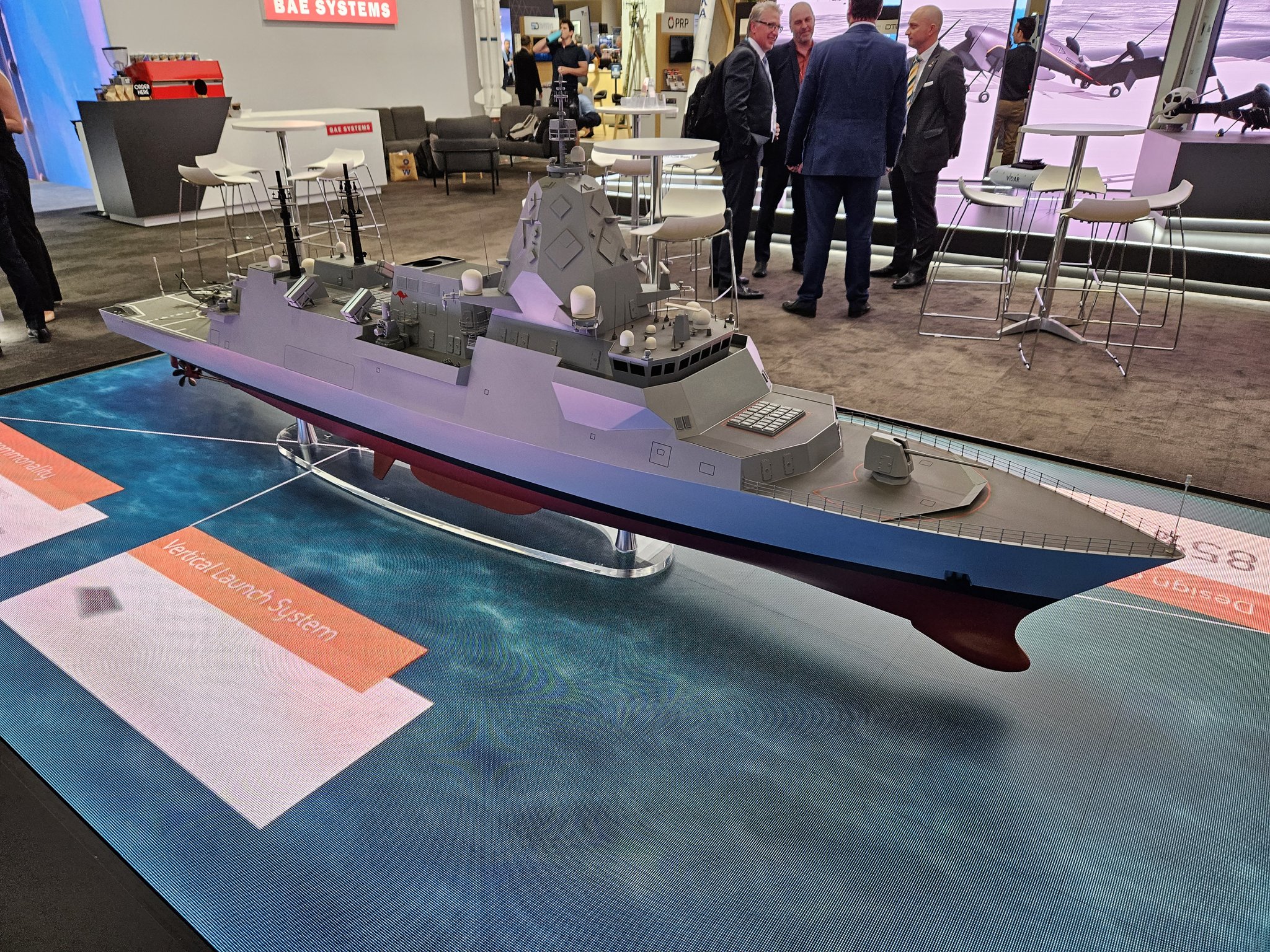
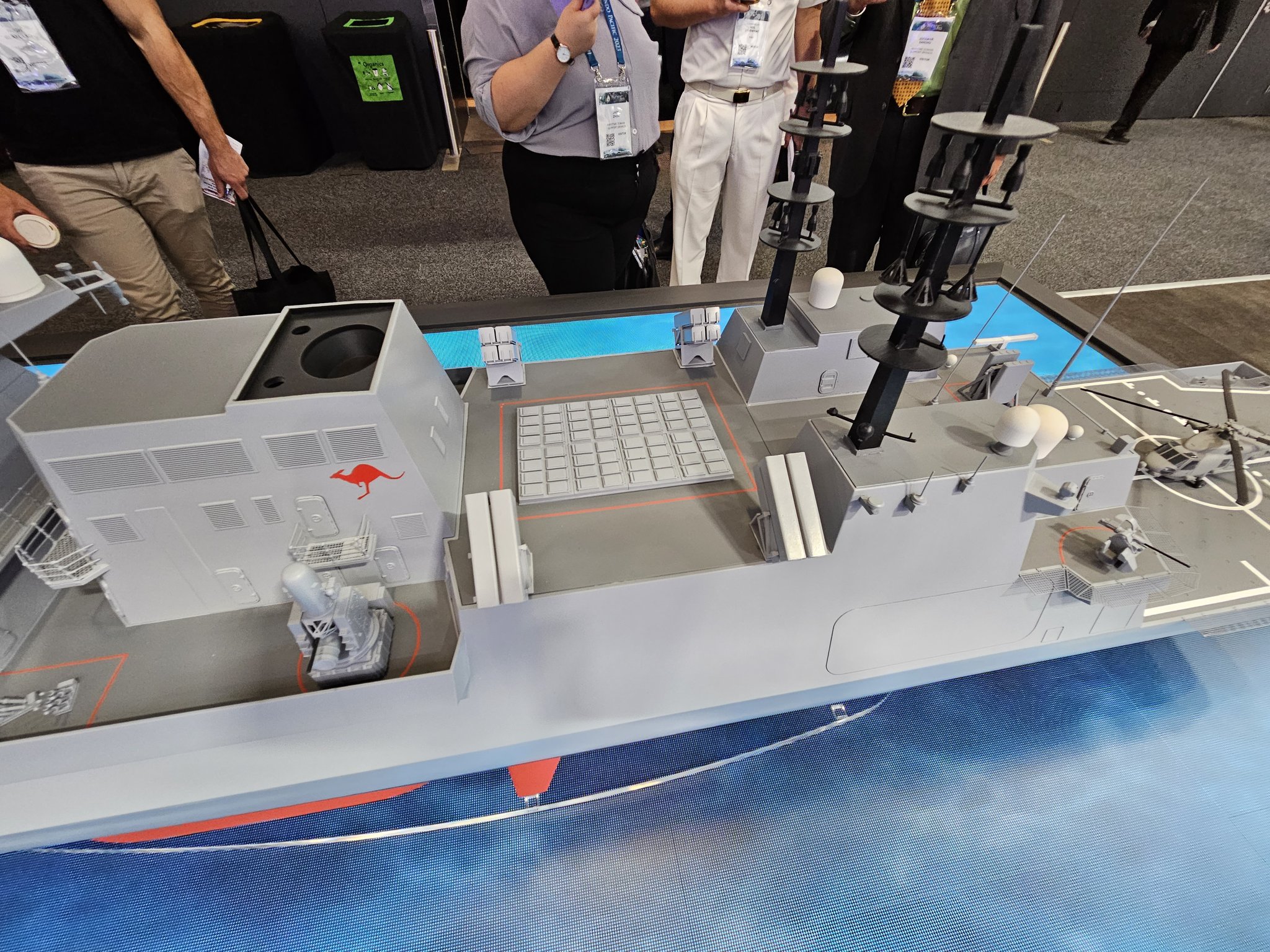
"If the RAN elected to remove the 5 inch Mk 45 gun, Lockhart said, it would enable the VLS count to grow even more to 128 cells – which surpasses even the United States Navy’s (USN) Ticonderoga class Guided Missile Cruisers. "
The 5" is equivalent to another 32 cells weight wise?
- Reaction score
- 7,380
- Points
- 1,160
- 24 Mark 41 VLS on the CSC + 24 shorter range missiles (I assume this refers to CAMM but it was not mentioned by name).
- Current missile armament is not viewed as sufficient against peer/future threats however, it was thought that the ship would need to be enlarged to fit more missiles and this would cause a variety of issues not deemed worthwhile.
- Options are being considered for unmanned or optionally manned vessels to act as missile magazines for the CSC.
Previously noted
"One destroyer and two USVs could replace three destroyers."
The USVs Mariner and Ranger are crewboat-based test platforms, designed for developing a concept of operations for unmanned vessels in the U.S. fleet. The program - dubbed "Ghost Fleet Overlord" - was developed by Pentagon's Strategic Capabilities Office (SCO) in coordination with the Navy. True to their roots as working vessels, these boats are capable of carrying large payloads on their back decks, including a containerized launcher for the SM-6 multi-purpose missile. This launch system has been tested before, and it could effectively transform the drone boat into an unmanned magazine ship for a U.S. strike group. "One destroyer and two USVs could replace three destroyers. It’s a force multiplier,” Cmdr. Jeremiah Daley (USN) told the Wall Street Journal last week.
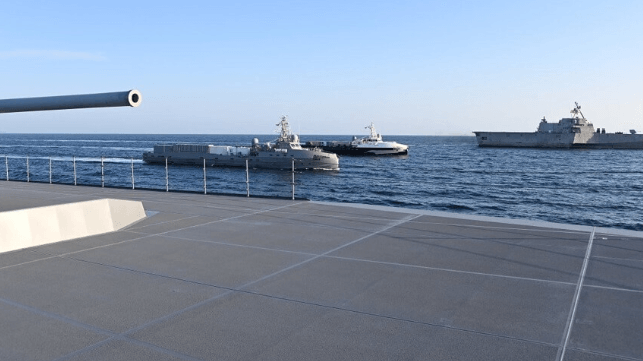
Japan's Navy Works Alongside U.S. Drone Ships in Trials Off Yokosuka
The U.S. Navy's "Ghost Fleet Overlord" unmanned vessels have attracted attention in exercises off Hawaii and the U.S. West Coast, and last week th...
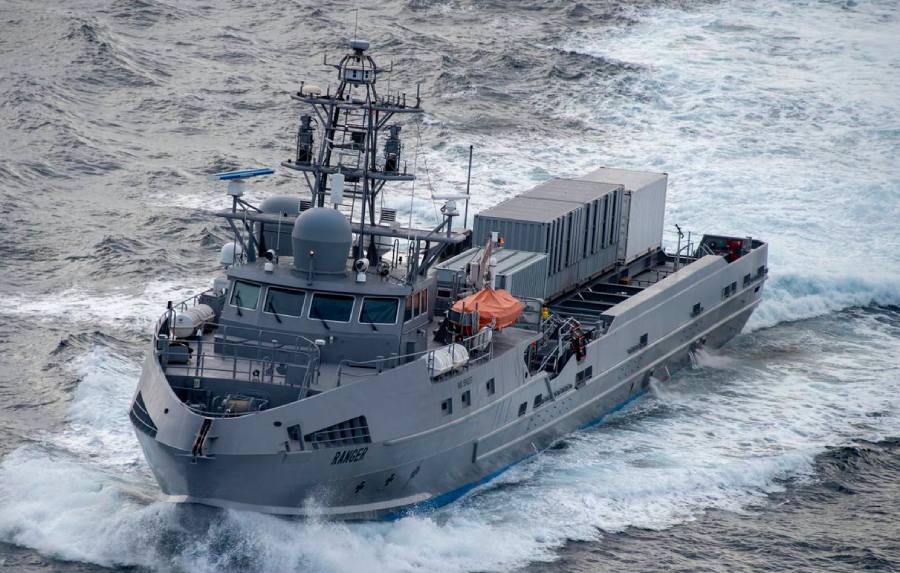
VESSEL REVIEW | Mariner & Ranger – US Navy launches new fleet of unmanned test vessels - Baird Maritime
The US Navy has begun operating two unmanned surface vehicles (USVs) as part of a US Department of Defense (DOD) project entailing the integration of autonomous navigation technology into existing seagoing vessels. Sister vessels Mariner and Ranger were developed by a partnership formed by...
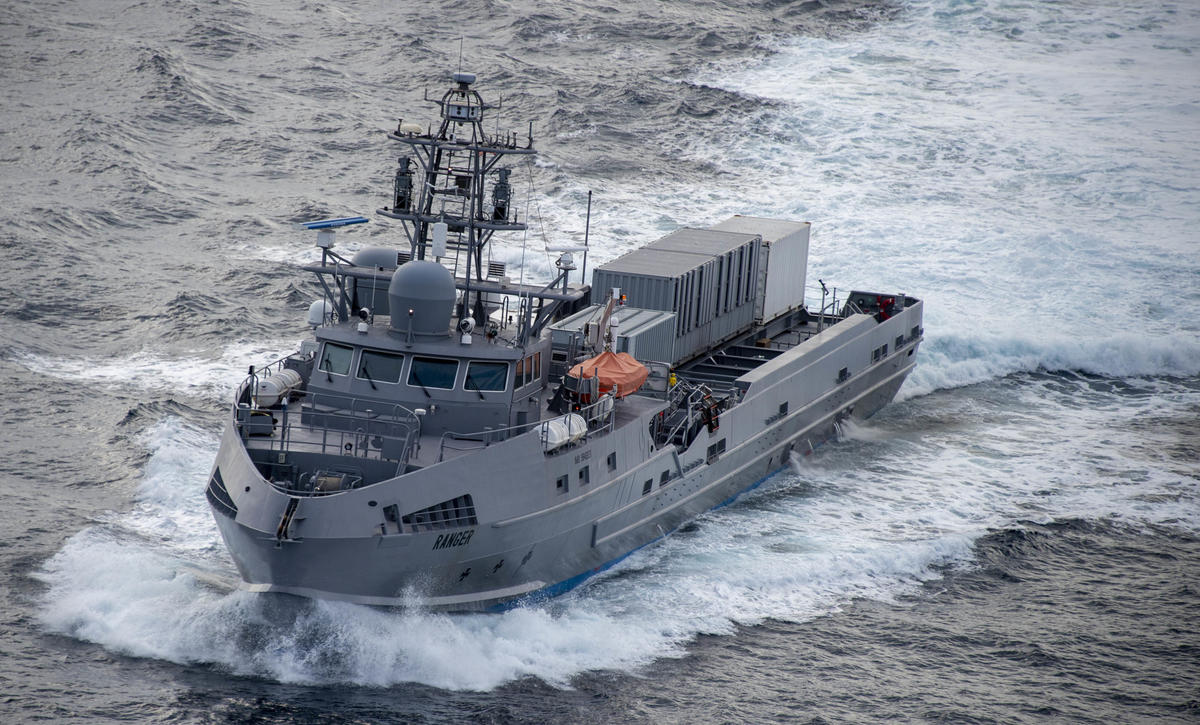
Leidos selected by U.S. Navy to operate and sustain medium unmanned vessels
Leidos to manage, operate and maintain the U.S. Navy’s Overlord and medium USVs.

Navy issues new RFI for large unmanned surface vessel
Naval Sea Systems Command issued a sources-sought notice for a robo-ship initiative that is a centerpiece of the service’s plans to field lethal, uncrewed vessels at sea as part of a “hybrid fleet” of manned and unmanned systems.
Gulf Craft, LLC - Custom Builders of Aluminum Boats - 190' Class (190' - 199')
Custom Builders of Aluminum Boats Committed to Quality and Service Since 1965
Gulf Craft, LLC - Custom Builders of Aluminum Boats - RJ Coco McCall
Custom Builders of Aluminum Boats Committed to Quality and Service Since 1965
If I can assume that Mariner is related to the RJ Coco McCall then this spec sheet might be a reasonable estimate.
DIMENSIONS
Length Overall | 190.00 ft. |
Length BP | 176.00 ft. |
Beam | 34.00 ft. |
Depth | 13.00 ft. |
Light Draft | 5.40 ft. |
Loaded Draft | 8.60 ft. |
Light Ship | 283.89 LT |
Dead Weight | 466 LT |
CAPACITIES
Drill / Fresh Water | 36,878 USG |
Fuel Oil | 68,007 USG |
Potable Water | 4,038 USG |
Main Engine Lube Oil | 1,228 USG |
Ballast Water | 7,776 USG |
Water Jet Lube Oil | 50 USG |
Sewage | 300 USG |
Bilge Oil | 1,404 USG |
Gear Oil | 120 USG |
Coolant | 220 USG |
Passengers | 54 |
Crew | 14 |
MACHINERY
Main Engines | 4 x MTU 16V4000M73 |
Brake Horsepower | 4 x 3,435 HP = 13,740 BHP @ 1970 RPM |
Gears | 4 x Twin Disc MG61500 |
Ratio | 2.97:1 |
Water Jets | 4 x Hamilton Jet HT900 |
Main Generators | 3 x 290 KW, 480 VAC, 60 Hz, 3 Phase |
Main Generator Drives | 3 x Cummins QSM11 |
Tunnel Bow Thrusters | 3 x Thrustmaster 200 HP |
Tunnel Bow Thruster Drives | 3 x 200 HP Electric Motor |
PERFORMANCE
Maximum Speed | 35 knots |
Cruising Speed | 31 knots |
Economy Speed | 24 knots |
Maximum Fuel Consumption | 661 GPH @ 1970 RPM |
Cruising Fuel Consumption | 495 GPH @ 1,800 RPM |
Economy Fuel Consumption | 274 GPH @ 1500 RPM |
DOCUMENTATION
Class | ABS +A1 HAS Crewboat +AMS +DPS2 |
Flag | US |
USCG | Subchapter T/L |
Official No. | 1231168 |
IMO No. | 9618109 |
DP Class | ABS DP2 |
IOPP/SOPEP | USCG |
Combustibles | USCG approved to carry in approved deck tanks |
Delivery | November 2011 |
TONNAGE
GRT | 97 (USA) |
NRT | 66 (USA |
DECK CARGO
Tonnage | 350 LT |
Strength | 540 lb./ft.2 |
Length | 123 ft. |
Width | 28 ft. |
Clear Area | 3,344 ft.2 |
Apparently a strike length 8 cell Mk41 is 2.1 m long by 3.2 m wide by 7.7 m long. It weighs 15 tonnes empty and 27.8 tonnes loaded with 8 Tomahawks at 1.6 tonnes each. SM6s are a bit lighter at 1.5 tonnes apiece.
With a deck tonnage of 350 long tons the boat will run out of displacement before it runs out of deck. 350 long tons divided by 27.8 tonnes results in 12 loaded Mk41s or 96 cells with Tomahawks or SM6s. Presumably the Mk 41s could penetrate the deck to lower the centre of mass.
If so then....
Once CSC "Destroyer" with a pair of Mariner/McCalls in company would be sporting 24 cells onboard plus 2x96 cells in company for a total loadout of 216 cells.
And would the LUSV magazines need any sensors beyond those necessary for navigation?
- Reaction score
- 13,141
- Points
- 1,010
I suddenly see a role for recently retired LCS…
- Reaction score
- 17,066
- Points
- 1,260
At Pennies on the dollar.I suddenly see a role for recently retired LCS…
- Reaction score
- 13,141
- Points
- 1,010
I’m kinda serious, here.At Pennies on the dollar.
if they are looking for hulls to bolt boxes of missiles onto, for other platforms to fire, this could work and fast.
- Reaction score
- 17,066
- Points
- 1,260
I don’t disagree with you.I’m kinda serious, here.
if they are looking for hulls to bolt boxes of missiles onto, for other platforms to fire, this could work and fast.
They have low crew requirements (relatively) and have a large area of mission configurable space to use.
Similar threads
- Replies
- 5
- Views
- 5K
- Replies
- 7
- Views
- 31K


